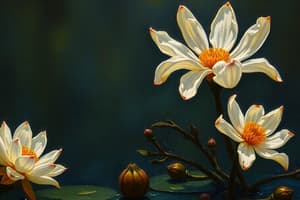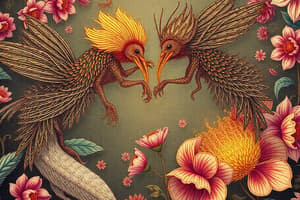Podcast
Questions and Answers
Which method of asexual reproduction involves separating a part of the parent plant to grow independently?
Which method of asexual reproduction involves separating a part of the parent plant to grow independently?
- Seed propagation
- Tissue culture
- Grafting
- Vegetative propagation (correct)
What must be included in a stem cutting for successful propagation?
What must be included in a stem cutting for successful propagation?
- Two nodes and an internode (correct)
- Only the root structure
- One flower and two nodes
- An entire leaf
In grafting, what is the rootstock also referred to as?
In grafting, what is the rootstock also referred to as?
- The stock (correct)
- The graft
- The shoot
- The scion
What does the stigma of a flower do?
What does the stigma of a flower do?
What is the correct sequence of steps in the tissue culture process?
What is the correct sequence of steps in the tissue culture process?
Which flower part is responsible for the production of pollen?
Which flower part is responsible for the production of pollen?
Why is grafting commonly used in fruit tree propagation?
Why is grafting commonly used in fruit tree propagation?
What type of flower contains both male and female reproductive parts?
What type of flower contains both male and female reproductive parts?
What is the primary function of the anther in a flower's stamen?
What is the primary function of the anther in a flower's stamen?
Which part of the flower is responsible for attracting pollinators?
Which part of the flower is responsible for attracting pollinators?
In the context of pollination, what is the result of pollen reaching the stigma?
In the context of pollination, what is the result of pollen reaching the stigma?
What is a key characteristic of asexual reproduction?
What is a key characteristic of asexual reproduction?
Which process involves the transfer of pollen from one flower to another of a different plant?
Which process involves the transfer of pollen from one flower to another of a different plant?
Which of the following is an advantage of sexual reproduction?
Which of the following is an advantage of sexual reproduction?
Which structure in the flower contains the egg cell that develops into a seed when fertilized?
Which structure in the flower contains the egg cell that develops into a seed when fertilized?
In agriculture, what is one of the main benefits of using asexual reproduction methods?
In agriculture, what is one of the main benefits of using asexual reproduction methods?
What role do vectors play in pollination?
What role do vectors play in pollination?
What is the thin stalk that supports the anther called?
What is the thin stalk that supports the anther called?
What is the primary disadvantage of asexual reproduction when considering environmental changes?
What is the primary disadvantage of asexual reproduction when considering environmental changes?
Which of the following is NOT a part of the flower's reproductive structures?
Which of the following is NOT a part of the flower's reproductive structures?
Which statement accurately describes sexual reproduction?
Which statement accurately describes sexual reproduction?
In terms of offspring production, how does asexual reproduction compare to sexual reproduction?
In terms of offspring production, how does asexual reproduction compare to sexual reproduction?
Which of the following characteristics is NOT associated with asexual reproduction?
Which of the following characteristics is NOT associated with asexual reproduction?
What is a common method used to produce plants through asexual reproduction?
What is a common method used to produce plants through asexual reproduction?
Flashcards
Vegetative Propagation
Vegetative Propagation
Asexual reproduction in plants where a part of the parent plant grows into a new plant.
Stem Cuttings
Stem Cuttings
A method of vegetative propagation where stems are cut and planted to grow new plants.
Grafting
Grafting
A type of vegetative propagation where a desirable part of one plant is attached to another plant's root system.
Tissue Culture
Tissue Culture
Signup and view all the flashcards
Flower (Angiosperms)
Flower (Angiosperms)
Signup and view all the flashcards
Hermaphrodite Flower
Hermaphrodite Flower
Signup and view all the flashcards
Unisexual Flower
Unisexual Flower
Signup and view all the flashcards
Pistil
Pistil
Signup and view all the flashcards
Sexual Reproduction
Sexual Reproduction
Signup and view all the flashcards
Asexual Reproduction
Asexual Reproduction
Signup and view all the flashcards
Gametes
Gametes
Signup and view all the flashcards
Meiosis
Meiosis
Signup and view all the flashcards
Mitosis
Mitosis
Signup and view all the flashcards
Genetic Variation
Genetic Variation
Signup and view all the flashcards
Rapid Population Growth
Rapid Population Growth
Signup and view all the flashcards
Adaptation
Adaptation
Signup and view all the flashcards
Ovary function
Ovary function
Signup and view all the flashcards
Ovule function
Ovule function
Signup and view all the flashcards
Stamen function
Stamen function
Signup and view all the flashcards
Pollination definition
Pollination definition
Signup and view all the flashcards
Sepal function
Sepal function
Signup and view all the flashcards
Petal function
Petal function
Signup and view all the flashcards
Cross-pollination
Cross-pollination
Signup and view all the flashcards
Self-pollination
Self-pollination
Signup and view all the flashcards
Study Notes
Reproduction Overview
- Reproduction is a biological process creating new individuals to ensure species survival and prevent extinction.
- Two main types exist: sexual and asexual.
Sexual Reproduction
- Involves two parents.
- Genetic material combines.
- Gametes (sex cells) are produced by meiosis.
- Gametes fuse during fertilization to form a zygote.
Asexual Reproduction
- Involves one parent.
- Offspring have the same genetic makeup as the parent.
- No gametes are involved.
- Process occurs via mitosis.
Differences Between Asexual and Sexual Reproduction
- Asexual:
- No gametes needed.
- One parent needed.
- No variation in offspring (identical).
- Happens quickly.
- Many offspring produced.
- Less energy required.
- Sexual:
- Gametes needed.
- Two parents needed.
- Variation in offspring.
- Happens slowly.
- Few offspring produced.
- More energy required.
Advantages of Asexual Reproduction
- Fast population growth in favorable conditions.
- Requires less energy.
- No need to find a mate.
- Offspring can easily adapt to the environment since they are identical to their parent.
- Few mutations occur.
Disadvantages of Asexual Reproduction
- No genetic diversity.
- Inability to adapt to changing environments.
- May lead to extinction.
Advantages of Sexual Reproduction
- Variation in offspring allows for better adaptation to changing environments.
Disadvantages of Sexual Reproduction
- Longer process due to gamete production.
- Fewer offspring produced, reducing survival chances.
- More energy is required.
Importance of Asexual Reproduction in Agriculture
- Cloning plants with desired characteristics creates identical offspring.
- Saves time and money by avoiding seed germination wait.
- Allows for faster crop production.
- Leads to the continuous production of better quality crops by allowing farmers to select desirable qualities.
Asexual Reproduction in Plants
- Also known as vegetative propagation.
- Part of the parent plant separates and grows independently.
- Common artificial methods include stem cuttings, grafting, and tissue culture.
Stem Cuttings
- Plant stems are cut into pieces.
- Placed in furrows and covered with soil.
- Pieces must include nodes and an internode.
- Roots and shoots grow from nodes.
Grafting
- Used for plants such as fruit trees to produce identical offspring from a single parent plant.
- Piece of a plant with desirable features is grafted onto a strong, resistant plant.
- A cut stem (scion) of one plant is attached to the rootstock of another plant (stock).
Tissue Culture
- Isolating cells with desired traits from a parent plant.
- Placing them in a sterile nutrient medium (often agar).
- Cells divide by mitosis to form plantlets.
- Plantlets are planted in soil.
Flowers as Reproductive Organs in Plants
- Flowers are the reproductive organs in flowering plants (angiosperms).
- Hermaphrodite flowers have both male and female parts on the same flower.
- Unisexual flowers have separate male and female flowers.
Floral Whorls
- Flowers have four floral whorls: sepals, petals, stamens, and pistils.
Structure of a Flower: Pistil
- Female reproductive structure.
- Stigma: sticky tip that traps pollen.
- Style: slender tube transporting pollen to the ovary.
- Ovary: contains ovules.
- Ovule: contains the egg cell, developing into a seed after fertilization.
Structure of a Flower: Stamen
- Male reproductive structure.
- Filament: thin stalk supporting the anther.
- Anther: knob-like structure producing pollen.
- Pollen: contains microscopic cells that become sperm cells.
Structure of a Flower: Sepals
- Encloses and protects the flower before it blooms.
Structure of a Flower: Petals
- Usually colorful and scented to attract pollinators.
Pollination and Fertilization
- Pollination: Pollen transfer from the anther to the stigma.
- Necessary for fertilization.
- Cross-pollination: Pollen from one flower to another on a different plant.
- Self-pollination: Pollen from one flower to the stigma of the same flower, or other flowers on the same plant.
Cross Pollination Steps
- Pollen from the anther is caught by the stigma.
- Travels through the style to ovules in the ovary.
- Via pollen tube.
- Result: fertilization.
Fertilization
- Pollen grain lands on the sticky stigma and develops a pollen tube.
- Pollen tube grows down the style to the ovary; fertilization occurs.
- Zygote produced.
- Ovary becomes fruit, ovules become seeds.
Seeds as Food Source
- Seeds store lots of food and are a vital food source.
- Categorized as grains, legumes, and nuts.
- Crucial as staple diets globally due to their affordability and nutritional value.
Seed Banks
- Used to preserve seeds and maintain biodiversity.
- Conserve endangered or extinct plant species.
- Rehabilitate damaged or destroyed habitats.
- Cultivate plants overused or develop new hybrids.
- Preserve endemic species.
Studying That Suits You
Use AI to generate personalized quizzes and flashcards to suit your learning preferences.




